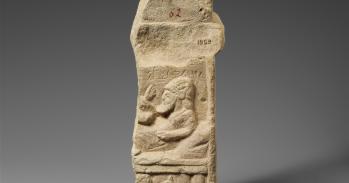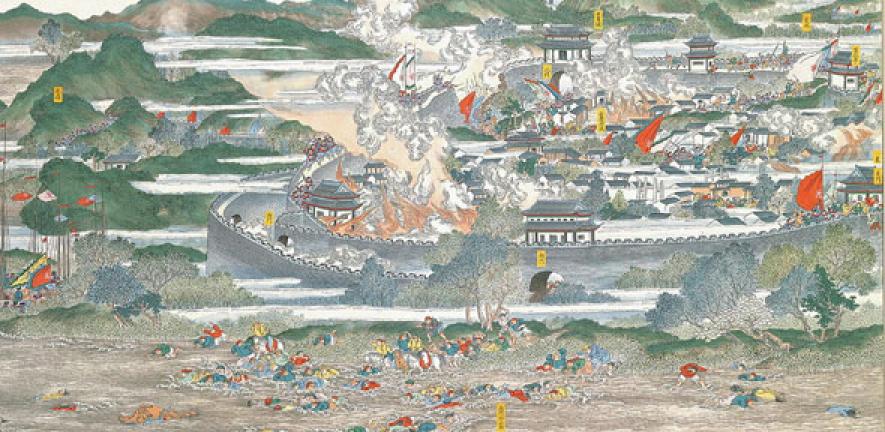
The siege of Anqing in central China was a pivotal episode in a civil war that saw the loss of 20 million lives. At a talk on Tuesday (11 March, 2014) Kang Tchou (Faculty of Asian and Middle Eastern Studies) will explain how the conflict that took place there prompted developments in logistics and weaponry that changed the face of warfare.
The siege of Anqing in central China was a pivotal episode in a civil war that saw the loss of 20 million lives. At a talk on Tuesday (11 March, 2014) Kang Tchou (Faculty of Asian and Middle Eastern Studies) will explain how the conflict that took place there prompted developments in logistics and weaponry that changed the face of warfare.
As every academic discovers, research opens up more questions than it answers and I found myself constantly re-examining the relationship between the printed text and realities on the ground.
Kang Tchou
In mid-19th century China, the great Qing Empire experienced an uprising that led to the death of at least 20 million people, roughly 5% of the population in the empire and nearly 2% of the global population. Known in contemporary Britain as the Taiping Rebellion, it is often described as the bloodiest civil war in history. The Taiping forces – composed of miners, smiths, charcoal burners, out-of-work coolies and former pirates -– faced the armies of the ruling Qing dynasty in a conflict that lasted 14 years. The conflict began in July 1850 with the gathering of a force numbering 20,000 at Thistle Mountain in Guangxi Province and ended in July 1864 with the Qing recovery of Nanjing.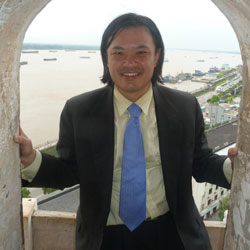
The Taiping Rebellion arose from tensions between the Hakka and Zhuang ethnicities and the Qing authorities, and had its roots in a heterodox Christianity called the God Worshipping Society. A crucial episode in the conflict was the campaign for Anqing, the provincial capital of Anhui in central China, which was taken by the Taiping in October 1853. The Qing siege of this walled city was the first of numerous sieges across all 18 provinces of the empire and it set the agenda for the much of the conflict to come.
Most notably, the siege of Anqing saw the Qing armies make their first use of ‘investment’ – a term to describe the severing of supply routes as a military tactic to bring about the fall of a city. At a talk on Tuesday 11 March, Kang Tchou, a PhD candidate in the Asian and Middle Eastern Studies Faculty at Cambridge University, will discuss the ways in which the campaign for Anqing spurred both sides in the conflict to introduce new military technologies and strategies.
Tchou chose to study at Cambridge for several reasons, among them the existence of unique resources held by the University Library (UL). The Wade Collection of Chinese and Manchu books (and western books about China) was presented to the UL in 1886 by Sir Thomas Francis Wade (1818-1895), who negotiated with both the Taiping and the Qing as Lord Elgin’s Chinese secretary. Wade later became first Professor of Chinese at Cambridge. Classified under "Miscellaneous" books, is a rare collection of ‘pamphlets issued by the Tai-pings during their great rebellion’.
The Taiping fought for their way of life and ultimately paid with their lives. When Anqing fell, an event documented by the diaries of a bureaucrat named Zhao Liewen on the personal staff of the Qing commander-in-chief Governor General Zeng Guofan, all its adult male inhabitants were slaughtered and more than 10,000 women were carried off by Qing soldiers as booty, sparing perhaps only some of the children. With them perished all first-hand experiences of holding out against the besieging forces that had surrounded them for almost two years – testing to the brink the patience and tenacity of the Qing and their superior military might. The Qing soldiers who entered the city on 5 September 1861 found evidence that the inhabitants had resorted to cannibalism for there were records that human flesh had a market rate of the equivalent of 50 pence per kilogram.
The items in the Wade Collection currently of greatest interest to Tchou are Taiping pamphlets, dealing with military operation and administration, as well as archival materials from the Ming-Qing archives, local gazetteers and data collected from field work while in China. Meticulous study of these materials, which are written in literary Chinese in documentary style and use traditional characters, is helping Tchou to build a realistic picture of a battle that has long been overlooked by historians.
The Wade Collection’s Taiping pamphlets, 32 in kind and 40 in number, represent an extraordinarily precious source for a historian of the period. “In China, there are just three of these pamphlets – which is an indication of the rarity of our collection,” says Tchou. “They were printed either with woodblock printing or moveable type and would have been circulated throughout the Taiping Kingdom and to foreign missionaries and the emissaries of foreign governments. Together they cover every aspect of the Taiping’s philosophies – from religious rituals, to military administration and organisation – and provide a window through which the historian can glimpse the past through the veil of historiography.”
It was essential that Tchou visited the sites he was researching and get a grasp of the physical terrain of the Anqing and its surroundings – and visit sites that survive to tell the story of the siege. Two years ago he flew from the UK to China to spend 11 months doing archival research at national and local archives, and carry out battle field surveys in central and southern Anhui. The trip was funded by a travel award from the Cambridge Overseas Trust. “As I sat on the plane, I ran through the objectives of my research which were to find primary and secondary sources and to verify them as much as possible through field work,” he said.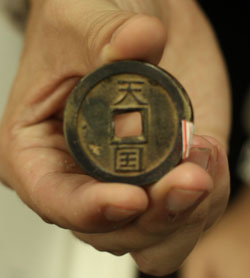
“As every academic discovers, research opens up more questions than it answers and I found myself constantly re-examining the relationship between the printed text and realities on the ground. I had set up appointments with scholars of modern Chinese history in national universities, local historians in Anhui province and organised access to the Ming-Qing Archives and Taiping History Museum – but I also wanted to find the actual location that the sources describe and the experts discuss.”
Today Anqing is a conurbation of 5.3 million people – a place where there is comparatively little evidence of either its turbulent history or modern China’s economic boom. The city lies on the northern bank of the Yangtze river and is reached from the north by the Jixian pass, a strategic entrance from northern Anhui into the outskirts of the city. It was its strategic location that led to Anqing being caught up in the ferocious conflict between the Taiping, who were holding fast to the city, and the Qing who surrounded it.
As the Qing gradually tightened their grip on the city, they encircled it with a line of circumvallation (circular fortifications) several kilometres in length, formed by earthen ramparts covered with a layer of thick stone that was further entrenched with rings of trenches filled with sharpened bamboo stakes to slow down enemy infantry. This line of defence was further protected with rings of sharpened thick wooden stakes to stop any potential cavalry charges. To protect their positions from Taiping forces sent to relieve the siege from their capital in Nanjing, Qing forces also built a second line of second line of contravallation (outer fortifications) using similar fortifications outside the line of circumvallation.
The Qing forces advanced slowly and painfully spending half a day on the march and the rest building temporary defences around their camps out of wood, mud and wet cotton. “Previous conflicts in China had been fought with hand weapons – swords, halberds, spears and swords and older types of firearms such as jingals and muskets – but now both sides began to use rifles and artillery pieces purchased from the European merchants in Shanghai and to manufacture their own versions of these military innovations. The use of these weapons transformed both the way of fighting and logistics necessary to supply the armies,” said Tchou.
“Rivers played a crucial role in transportation of food, weapons and munitions. A few years ago you could find a local family living on boats to take you to Anqing but now there are only luxury tourist cruises on the Yangtze river. However, traveling by the inter-county roads you can still see how the complex waterways with the smaller channels and tributaries were ideal for smuggling supplies and rifles and artillery, sold by British merchants in Shanghai, past the besieging armies and into the walled city.”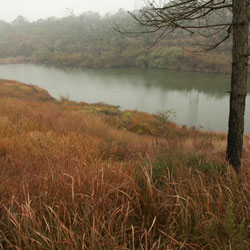
The Taiping rebels holding out inside Anqing were predominantly Hakka and Zhuang. The Hakka were traditional builders of village fortifications and the Zhuang were charcoal burners and miners which meant that they were expert in tunnelling and building fortifications – evidence of tunnels and lines of circumvallation and contravallation are still visible today. Tchou said: “One of my greatest surprise discoveries was at the location of Jixian pass, where you can see the ruins of the stone fortification that formed either the line of circumvallation or contravallation. According to my guide, a local refuse collector who as a child walked his younger sister everyday over Jixian pass so that she could attend school in the city, the ruins run for at the least 2 kilometres atop the mountains to the north of Anqing.”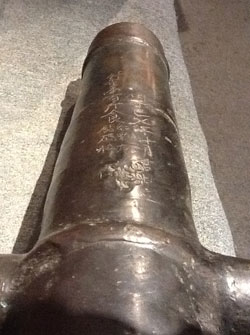
Both the French and the British got involved in the Taiping Rebellion by sending forces to defend their interests in treaty ports such as Shanghai. Their motivation lay in their desire to choose the winning side — the side that could guarantee their right to trade in all of China. Either as regular forces of the respective governments or as mercenaries for hire, veterans of the Crimean War (1853-6) and soldiers who were trained to fight in the US Civil war (1861-5) brought with them new Anglo-American and European methods of warfare that included the use of the latest rifles and field artillery and concepts of logistics and administration and the use of steamships in riverine navies.
Tchou hopes that his presentation will lead to a discussion of new approaches to non-European wars that were fought in the 19th century and demonstrate how much there is still left to discover on a topic that is either considered ‘forgotten’ or ‘already been done’.
The talk New Perspectives on the Taiping and Qing Civil War: Rediscovering Anqing, as a Place of Innovation in Nineteenth Century Warfare will take place on Tuesday, 11 March, 2014 at 5pm in the Rushmore Room, St Catharine’s College, Cambridge. All welcome. For more information contact Rudolph Ng rn339@cam.ac.uk
For more information on this story contact Alexandra Buxton, Office of Communications, University of Cambridge, amb206@admin.cam.ac.uk 01223 761673.
Inset images: Kang Tchou in Anqing, detail from a Taiping pamphlet in the Wade Collection, Taiping coin, river inlet diverted for smelting, Taiping cannon.
This work is licensed under a Creative Commons Licence. If you use this content on your site please link back to this page.





